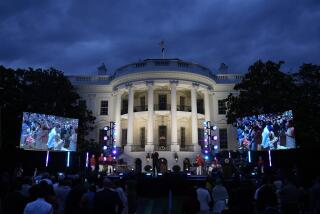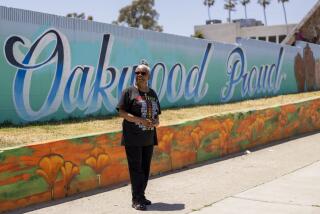Selma marchers recall ‘a sense that we were all in this together’
Many black residents of Selma who lived through the marches 50 years ago recall the time with a mix of nostalgia and heartbreak; they’re overjoyed that history was made but saddened by the price it extracted.
“It was a painful time but also an exciting time,” Clara Hunter, 58, and a lifelong resident of Selma, said in a recent interview. Hunter rode all the way in the back of a truck from Selma to Montgomery during the successful third attempt at a march, joining various family members in the convoy.
“I don’t even remember where I slept. I was so young, but even then I think I knew how important it was to be there,” she said.
Older residents felt those March 1965 days even more pointedly.
Francis Felles, 94, said that she recalled all the years when restaurant owners would make her enter near the back or wait hours even when no one was in line. “And the whole thing with the poll tax. They’d say, ‘You fill out a form,’ and then they’d say, ‘We’ll get back to you.’ I haven’t heard from them yet,” she said.
Felles, a retired teacher, remembered a fellow educator at her school becoming involved in a confrontation with Jim Clark, the notorious anti-integration sheriff during the time of the marches. “She just slapped him,” Felles said, giving a tart laugh. “He didn’t bother her after that. He bothered other people, but not her.”
“Bloody Sunday” still evokes raw memories for many Selma residents, even for those who were not on the Edmund Pettus Bridge. That day, screams wafted over the town; nurses and doctors were called in to Good Samaritan Hospital as the wounded began pouring in.
At a downtown diner, Calvin Griffin, 58, and like the others a lifelong Selma resident, remembered the events of March 7, 1965, as he bused some tables.
“There were people lying on the floor bloody. There were policemen with billy clubs,” he said. “My mother was very protective of me and kept trying to keep me from the bridge so I wouldn’t see it. But I saw it anyway.”
Elizabeth Spencer, 62, said she was similarly traumatized that day, but then gladdened by how the chaos gave rise to community when the march came off two weeks later.
“You ate wherever somebody opened a door,” she said of the gatherings that preceded the march as well as the 55-mile journey that followed. “There was a sense that we were all in this together.”
Then she echoed the sentiment of a lot of older residents in Selma: “But it’s different now. Young folks, they don’t know how to keep the fight going.”
At the Sneakers shoe store on a corner of downtown’s main Broad Street artery, two blocks from the bridge, a group of black and white employees talked about the present state of affairs.
Two workers, Robin Small, 19 and white, and Meontre Hester, 21 and black, said they’d never experienced racism.
Their friend, 19-year-old Ronaldo Flowers, who is black, had a sharper opinion.
“I’ll say it, there are still racists in this town,” Flowers said. “But you know what happens? Their grandkids go off to school, and they come home with mixed-race babies, and suddenly they have to learn not to be racist.”
But even those who agree that race relations have improved note that discrimination comes in more subtle forms -- especially via a larger sense of economic disenfranchisement. Unemployment in Selma remains high, particularly for black residents.
“Before the late 1960s, blacks couldn’t do anything,” Griffin said. “ It got a little better in the late ‘60s and in the late ‘70s. And in the early ‘80s it got good because we had jobs; there were factories and other jobs whites didn’t really want to work at.
“Candle factories, battery places.” He sighed. “But now it’s bad again.”
Griffin had pieced together a living as a waiter and busboy in restaurants around town, even as some had closed and others weren’t hiring.
He took out a stack of postcards from his coat that showed images of magazine covers from March 1965. “I think I’m going to sell these,” he said. “You know, with so many people interested in the anniversary, maybe I can make some money.”
Twitter: @ZeitchikLAT
More to Read
Sign up for Essential California
The most important California stories and recommendations in your inbox every morning.
You may occasionally receive promotional content from the Los Angeles Times.










